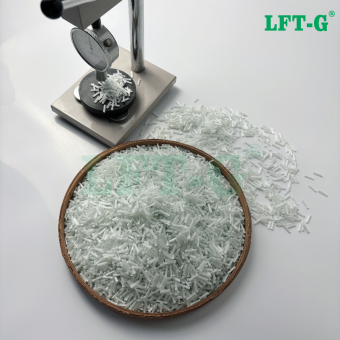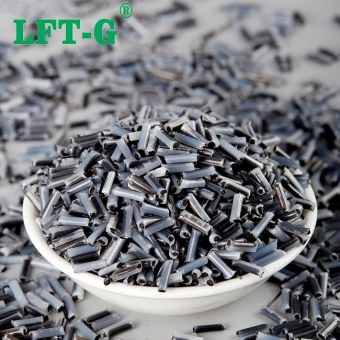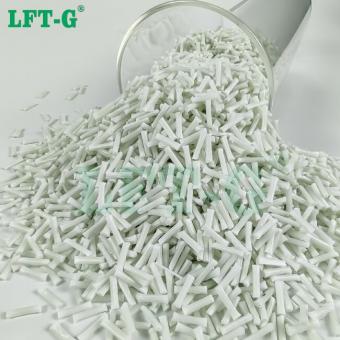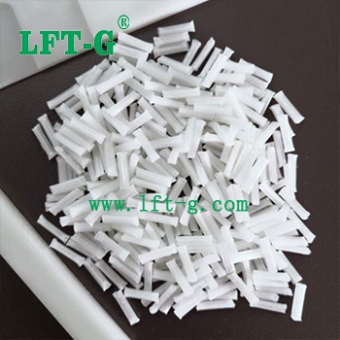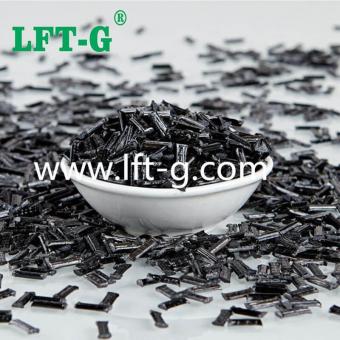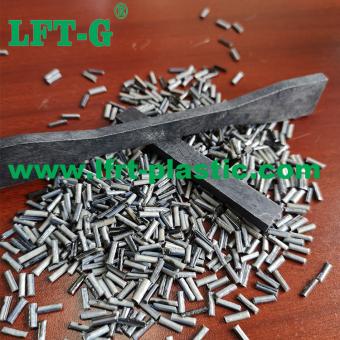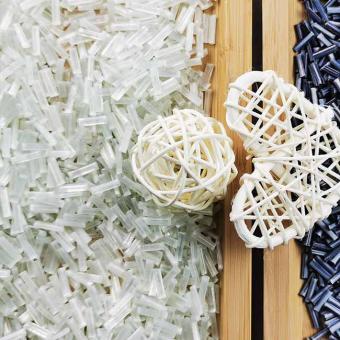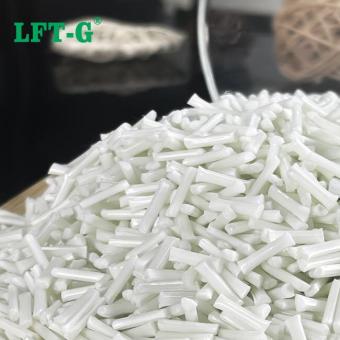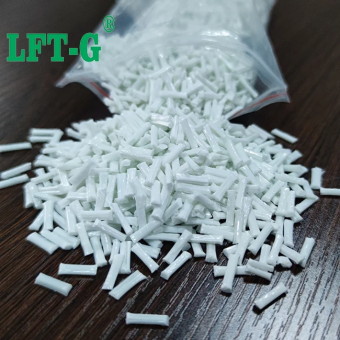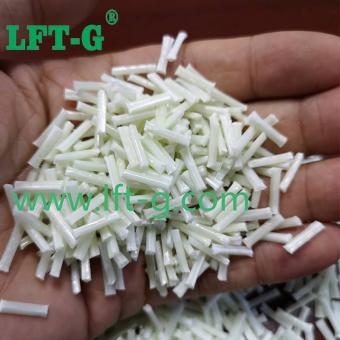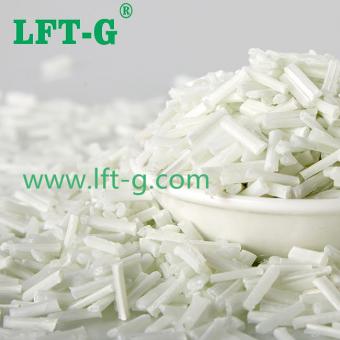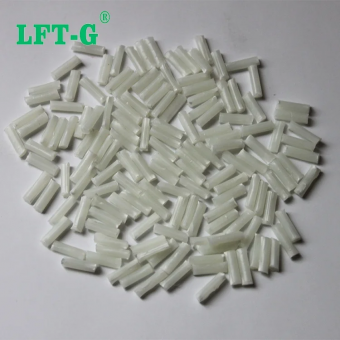-
Xiamen LFT-G PLA resina termoplástica composta de ácido polilático de fibra de carbono longaO que é PLA de fibra de carbono longa? Embora os termoplásticos de ácido polilático (PLA) de base biológica sejam relativamente ecológicos e fáceis de reciclar, os compósitos como a fibra de carbono são muito mais resistentes.O PLA reforçado com fibra de carbono longa é um material excelente, forte, leve, com excelente ligação de camadas e baixo empenamento. Possui excelente adesão de camada e baixo empenamento. O PLA longo de fibra de carbono é mais forte do que outros materiais impressos em 3D. Filamentos longos de fibra de carbono não são tão fortes quanto outros materiais 3D, mas são mais resistentes. O aumento da rigidez da fibra de carbono significa maior suporte estrutural, mas redução da flexibilidade geral. É um pouco mais frágil que o PLA normal. Quando impresso, o material tem uma cor escura e brilhante que brilha levemente sob luz direta. O que é fibra de carbono longa? Compósitos longos reforçados com fibra de carbono oferecem economia significativa de peso e proporcionam ótimas propriedades de resistência e rigidez em termoplásticos reforçados. As excelentes propriedades mecânicas dos compósitos longos reforçados com fibra de carbono tornam-nos um substituto ideal para metais. característica A tensão de fratura é moderada (8-10%), então a seda não é quebradiça, mas tem forte tenacidade Muito alta resistência à fusão e viscosidadeBoa precisão dimensional e estabilidadeFácil de manusear em muitas plataformasSuperfície preta fosca altamente atraenteExcelente resistência ao impacto e leveza Aplicação de materiais PLA de fibra de carbono longa O PLA de fibra de carbono longa é um material ideal para estrutura, suporte, casco, hélice, instrumento químico e assim por diante. Os fabricantes de drones e os entusiastas do RC também gostam especialmente dele. Ideal para aplicações que exigem máxima rigidez e resistência. Detalhes Número PLA-NA-LCF30 Cor Preto original (pode ser personalizado) Comprimento 12mm (pode ser personalizado) MOQ 20kg Pacote 20kg/saco Amostra Disponível Prazo de entrega 7-15 dias após o envio Porto de Lo ading Porto de Xiamen Exposição Nós lhe ofereceremos: 1. Parâmetros técnicos de materiais LFT e LFRT e design de ponta 2. Projeto frontal do molde e recomendações 3. Fornecer suporte técnico, como moldagem por injeção e moldagem por extrusão
- Resina de cor original PLA LCF fabricada na China
- Ácido polilático preenchendo fibra de carbono longa
- Pelotas de plástico reforçado com resina PLA lcf
- Venda direta do fabricante LFT cpmpounds pla
- lcf material reforçado pla bom preço
- Termoplástico pla lcf em vez de metal CF
Tags :
-
Xiamen LFT-G PLA resina termoplástica composta de ácido polilático de fibra de carbono longaO que é PLA de fibra de carbono longa? Embora os termoplásticos de ácido polilático (PLA) de base biológica sejam relativamente ecológicos e fáceis de reciclar, os compósitos como a fibra de carbono são muito mais resistentes.O PLA reforçado com fibra de carbono longa é um material excelente, forte, leve, com excelente ligação de camadas e baixo empenamento. Possui excelente adesão de camada e baixo empenamento. O PLA longo de fibra de carbono é mais forte do que outros materiais impressos em 3D. Filamentos longos de fibra de carbono não são tão fortes quanto outros materiais 3D, mas são mais resistentes. O aumento da rigidez da fibra de carbono significa maior suporte estrutural, mas redução da flexibilidade geral. É um pouco mais frágil que o PLA normal. Quando impresso, o material tem uma cor escura e brilhante que brilha levemente sob luz direta. O que é fibra de carbono longa? Compósitos longos reforçados com fibra de carbono oferecem economia significativa de peso e proporcionam ótimas propriedades de resistência e rigidez em termoplásticos reforçados. As excelentes propriedades mecânicas dos compósitos longos reforçados com fibra de carbono tornam-nos um substituto ideal para metais. característica A tensão de fratura é moderada (8-10%), então a seda não é quebradiça, mas tem forte tenacidade Muito alta resistência à fusão e viscosidadeBoa precisão dimensional e estabilidadeFácil de manusear em muitas plataformasSuperfície preta fosca altamente atraenteExcelente resistência ao impacto e leveza Aplicação de materiais PLA de fibra de carbono longa O PLA de fibra de carbono longa é um material ideal para estrutura, suporte, casco, hélice, instrumento químico e assim por diante. Os fabricantes de drones e os entusiastas do RC também gostam especialmente dele. Ideal para aplicações que exigem máxima rigidez e resistência. Detalhes Número PLA-NA-LCF30 Cor Preto original (pode ser personalizado) Comprimento 12mm (pode ser personalizado) MOQ 20kg Pacote 20kg/saco Amostra Disponível Prazo de entrega 7-15 dias após o envio Porto de Lo ading Porto de Xiamen Exposição Nós lhe ofereceremos: 1. Parâmetros técnicos de materiais LFT e LFRT e design de ponta 2. Projeto frontal do molde e recomendações 3. Fornecer suporte técnico, como moldagem por injeção e moldagem por extrusãoVeja mais
-
LFT-G PEEK Resina termoplástica de fibra de carbono longa composta de poliéter éter cetonaPEEK-LCF Poliéter éter cetona (abreviado PEEK) não só tem excelentes propriedades mecânicas, térmicas e de resistência química, e baixo coeficiente de atrito, boa malha de rolamento, é outro tipo de bom material autolubrificante após o politetrafluoroetileno (PTFE), na capacidade de rolamento e resistência ao desgaste do que o desempenho do PTFE é melhor. Sem lubrificação, baixa velocidade e alta carga, alta temperatura, umidade, poluição, corrosão e outros ambientes adversos são especialmente adequados. Nesta base, a adição de fibra de carbono não só melhora as suas propriedades mecânicas, como também o seu desempenho de fricção tem uma influência importante. À temperatura ambiente, a resistência à tração do composto PEEK reforçado com 30% de fibra de carbono dobrou e atingiu três vezes a 150 ℃. Ao mesmo tempo, a resistência ao impacto, a resistência à flexão e o módulo do compósito reforçado também foram bastante melhorados, o alongamento foi drasticamente reduzido e a temperatura de deformação térmica pode exceder 300 ℃. A taxa de absorção de energia de impacto do compósito afeta diretamente o desempenho de impacto do compósito. O compósito PEEK reforçado com fibra de carbono apresenta uma capacidade específica de absorção de energia de até 180kJ/kg. O efeito reforçado da fibra de carbono também pode resistir ao amolecimento térmico do PEEK e formar um filme de transferência com resistência muito alta até certo ponto, o que pode proteger eficazmente a área de contato. Portanto, o coeficiente de atrito e a taxa de desgaste específica do compósito PEEK reforçado com fibra de carbono são significativamente inferiores aos do PEEK puro. Sob as mesmas condições experimentais, a resistência ao atrito e ao desgaste dos compósitos PEEK reforçados com fibra de carbono é obviamente melhor do que a dos compósitos PEEK de fibra de vidro, e o efeito de melhoria da fibra de carbono na resistência ao desgaste dos materiais é mais de 5 vezes maior que o da fibra de vidro. com a mesma dosagem. O material compósito PEEK reforçado com fibra de carbono é usado na fabricação de peças, o que pode efetivamente evitar rachaduras superficiais de materiais metálicos ou cerâmicos, e suas excelentes propriedades tribológicas excedem até mesmo as do polietileno de massa molar ultra-alta. TDS Aplicativo Long carbon fiber reinforced PEEK is mainly applied in the following four areas:1. Electronic and electrical appliancesPEEK can maintain good electrical insulation in the harsh environment such as high temperature, high pressure and high humidity, and has the characteristics of non-deformation in a wide temperature range, so it is used as an ideal electrical insulation material in the field of electronic and electrical appliances. The mechanical properties, chemical corrosion resistance, radiation resistance and high temperature resistance of polyether ether ketone reinforced by carbon fiber have been further improved, and its application fields have been further expanded.2. AerospacePolyether ether ketone PEEK has the advantages of low density and good workability, so it is easy to be directly processed into high-demand parts, and carbon fiber reinforced polyether ether ketone composite material further enhances the overall performance of polyether ether ketone, so it is increasingly used in aircraft manufacturing. The fairing on Boeing's 757-200 series aircraft, for example, is made from carbon-fiber reinforced PEEK. In addition, Gereedschappen Fabrick of Amsterdam, the Netherlands, used a 30% carbon fiber reinforced PEEK composite to build a larger component and demonstrated that its mechanical properties could be used in aircraft balancing devices.3. AutomotiveAutomobile energy consumption is closely related to vehicle weight. Automobile lightweight can not only reduce fuel consumption and exhaust emissions, but also improve power performance and safety, which is an effective way to save energy. In addition to the lightweight design of the structure, the use of lightweight materials is a more direct method. With its advantages of low density, good performance and convenient technology, carbon fiber reinforced polyether ether ketone composites are more and more frequently used in the automobile industry, and show great potential of replacing steel with plastic. For example, Robert Bosch GmbH uses carbon fiber reinforced PEEK instead of metal as a feature of ABS. The lighter composite part reduces moment of inertia, which minimizes reaction times, greatly enhances the overall system's reactivity, and reduces costs compared to previously used metal parts.4. HealthcareOs materiais poliméricos médicos atualmente disponíveis são politetrafluoroetileno, ácido polilático, borracha de silicone e dezenas de tipos, mas do ponto de vista da biomedicina, esses materiais não são ideais, no uso de alguns efeitos colaterais, e resina PEEK por causa de sua não-tóxica , peso leve, resistência à abrasão e outras vantagens, é o material mais próximo d...
- Fibra de carbono longa PEEK
- espiar plástico composto modificado
- espiar resina modificada venda direta
- espiar aeronave lcf lft usar campos aeroespaciais
- espiada longa em fibra de carbono altamente exigente
- moldagem por injeção espiada bom preço
Tags :
-
Sulfeto de polifenileno LFT-G PPS com resina termoplástica de fibra de carbono longa, alta rigidez e resistênciaInformações PPS O sulfeto de polifenileno (PPS) não é aprimorado antes da modificação, suas desvantagens são quebradiços, baixa tenacidade, baixa resistência ao impacto, após o enchimento de fibra de vidro, fibra de carbono e outros aprimoramentos modificados para superar as deficiências acima, para obter um desempenho geral muito bom. Enchimento PPS Fibra de carbono longa Na indústria de plásticos de engenharia modificados, os compósitos reforçados com fibras longas são compostos feitos de fibras longas de carbono, fibras longas de vidro e matriz polimérica através de uma série de métodos especiais de modificação. A característica mais importante dos compósitos de fibra longa é que eles apresentam desempenho superior que os materiais originais não possuem. Se os classificarmos de acordo com o comprimento dos materiais de reforço adicionados, eles podem ser divididos em: fibra longa, fibra curta e compósitos de fibra contínua. Os compósitos longos de fibra de carbono são um tipo de compósitos reforçados com fibras longas, que são um novo material de fibra com alta resistência e alto módulo. É um novo material com excelentes propriedades mecânicas e muitas funções especiais. Resistência à corrosão: os materiais compostos de fibra de carbono LCF têm boa resistência à corrosão e podem se adaptar ao ambiente de trabalho hostil. Resistência UV: a capacidade de resistir aos UV é forte e os produtos são menos danificados pelos UV. Resistência à abrasão e ao impacto: a vantagem de comparar com materiais em geral é mais óbvia. Baixa densidade: menor densidade do que muitos materiais metálicos, pode atingir o objetivo de peso leve. Outras propriedades: como redução de empenamento, melhoria da rigidez, modificação de impacto, aumento da tenacidade, condutividade elétrica, etc. Os compósitos de fibra de carbono LCF têm maior resistência, maior rigidez, menor peso e excelente condutividade elétrica em comparação com a fibra de vidro. PPS TDS para referência Aplicação PPS Outros produtos você também pode entrar em contato conosco para obter mais conselhos técnicos. Perguntas e respostas 1. Os produtos compostos de fibra de carbono são muito caros? O preço dos produtos compósitos de fibra de carbono está intimamente relacionado ao preço das matérias-primas, ao nível de tecnologia e ao número de produtos. Quanto maior o desempenho da matéria-prima, mais cara ela é, como o material termoplástico PEEK de fibra de carbono usado em ortopedia. É claro que quanto mais complexo for o processo de fabricação, maiores serão o tempo e a carga de trabalho e maiores serão os custos de produção. Porém, quanto maior a quantidade do pedido, menor será o custo por produto. No longo prazo, o desempenho superior da fibra de carbono prolongará a vida útil do produto, reduzirá o número de manutenções e também será muito benéfico para reduzir o custo de uso. 2. Os produtos compostos de fibra de carbono são tóxicos? Os compósitos de fibra de carbono são feitos de filamentos de fibra de carbono misturados com cerâmica, resinas, metais e outros substratos e geralmente não são tóxicos. Por exemplo, o material PEEK acima mencionado é feito de resina de qualidade alimentar, que é muito compatível com o corpo humano e não só é inofensivo para os seres humanos, mas também se torna um material mais ideal para cirurgia ortopédica devido à sua alta resistência e elasticidade. módulo próximo ao córtex ósseo. A placa médica de fibra de carbono, estará em contato diário com o corpo de muitos pacientes, não terá efeitos adversos no corpo humano, pelo contrário, para a precisão do diagnóstico médico e uma grande ajuda. 3. Qual é a diferença entre compósitos termofixos de fibra de carbono e compósitos termoplásticos de fibra de carbono? Os compósitos termofixos de fibra de carbono favorecem o papel de agente de cura na cura e moldagem. Enquanto os produtos compostos de fibra de carbono termoplástica dependem principalmente do resfriamento para obter a modelagem. Os compósitos termoplásticos de fibra de carbono não são tão populares quanto os compósitos termofixos de fibra de carbono, principalmente porque são caros e geralmente usados em indústrias de ponta. Os compósitos termofixos de fibra de carbono são difíceis de reciclar devido à limitação da própria matriz de resina e geralmente não são considerados; os compósitos termoplásticos de fibra de carbono podem ser reciclados e podem ser produzidos duas vezes mais, desde que sejam aquecidos a uma determinada temperatura. Sobre nós Nós lhe ofereceremos: 1. Parâmetros técnicos de materiais LFT e LFRT e design de ponta 2. Projeto frontal do molde e recomendações 3. Fornecer suporte técnico, como moldagem por injeção e moldagem por extrusão
- Polifenil PPS com adição e enchimento
- Aparelho eletrônico de baixo empenamento
- matéria prima dos grânulos pps lcf40
- Filamento longo de injeção de fibra de carbono PPS
- peça de injeção plástica pps LCf40
- Pelota pps lcf reforçada com fibra de carbono
Tags :
-
A resina termoplástica do poliuretano de Xiamen LFT encheu plásticos de engenharia longos da fibra de vidro de grande resistênciaIntrodução à TPU Os elastômeros de poliuretano termoplástico (TPU) são polímeros lineares formados pela copolimerização de segmentos de cadeia dura e mole, que possuem propriedades físicas como resistência à tração, abrasão e ao calor, e elasticidade semelhante à da borracha. Graças ao excelente desempenho do produto, os campos de aplicação do TPU estão se expandindo, incluindo bens de consumo diário, construção, medicina, militar, automotivo, agricultura e muitos outros campos. Novos produtos e aplicações também estão surgindo, como mangueiras de grande diâmetro (extração de gás de xisto), cabos de carregamento para veículos de novas energias, entressolas de calçados esportivos em TPU (ETPU) espumadas preparadas por processo de formação de espuma supercrítica, suspensórios invisíveis, etc. Compósitos de TPU modificados reforçados com fibra O TPU tem boa resistência ao impacto, mas em algumas aplicações é necessário alto módulo de elasticidade e material muito duro. A modificação reforçada com fibra de vidro é um meio técnico comum para melhorar o módulo de elasticidade do material. Através da modificação, podem ser obtidos compósitos termoplásticos com muitas vantagens, como alto módulo de elasticidade, bom isolamento, resistência ao calor, boa recuperação elástica, boa resistência à corrosão, resistência ao impacto, baixo coeficiente de expansão e estabilidade dimensional. Fibra de vidro longa VS Fibra de vidro curta Comparada com a fibra curta, a fibra longa tem desempenho mais excelente nas propriedades mecânicas. É mais adequado para produtos grandes e peças estruturais. Tem tenacidade 1-3 vezes maior do que a fibra curta e a resistência à tração é aumentada em 0,5-1 vezes. Termoplásticos VS Termofixos Termofixos: quando aquecidos pela primeira vez, podem amolecer e fluir, e quando aquecidos a uma determinada temperatura, produzem uma reação química uma cura de cadeia cruzada e endurecem, essa alteração é irreversível, depois disso, quando aquecidos novamente, eles não pode mais ficar suave e fluir. Termoplástico: a resina termoplástica é o componente principal e vários aditivos são adicionados para formar um plástico. Sob certas condições de temperatura, o plástico pode ser amolecido ou derretido em qualquer formato, e o formato permanece inalterado após o resfriamento; este estado pode ser repetido muitas vezes e sempre tem plasticidade, e esta repetição é apenas uma mudança física. Vantagens Termofixos: Os plásticos termofixos mantêm sua resistência e forma mesmo quando aquecidos. Isso torna os plásticos termofixos ideais para a produção de peças permanentes e formatos grandes e fortes. Além disso, essas peças possuem excelentes propriedades de resistência (apesar de sua fragilidade) e não perdem resistência significativa quando expostas a temperaturas operacionais mais elevadas. Termoplásticos: Os termoplásticos são os plásticos mais utilizados e normalmente apresentam alta resistência química e térmica, bem como uma estrutura de alta resistência que não se deforma facilmente. É feito de resina termoplástica como componente principal com diversos aditivos. Os produtos termoplásticos possuem excelente isolamento elétrico, com constante dielétrica e perda dielétrica muito baixas, adequados para materiais de isolamento de alta frequência e alta tensão. Aplicações TPU-LGF TDS para TPU-LGF Detalhes dos produtos Número Comprimento Cor Amostra Preço Quantidade mínima Pacote Prazo de entrega TPU-NA-LGF30 12mm (pode ser personalizado) Cor natural (pode ser personalizada ) Disponível Precisa ser confirmado 25kg 25kg/saco 7-15 dias após o envio Sobre nós Empresa Xiamen L FT plástico composto Co., Ltd. é uma empresa de marca que se concentra em LFT e LFRT. Série Longa de Fibra de Vidro (LGF) e Série Longa de Fibra de Carbono (LCF). O LFT termoplástico da empresa pode ser usado para moldagem por injeção e extrusão LFT-G, e também pode ser usado para moldagem LFT-D. Pode ser produzido de acordo com as necessidades do cliente: 5~25mm de comprimento. Os termoplásticos reforçados com infiltração contínua de fibra longa da empresa passaram pela certificação do sistema ISO9001 e 16949, e os produtos obtiveram muitas marcas e patentes nacionais.
- tpu lgf30 para biqueira aprimorada
- devido a pelotas de tpu em vez de metal
- tpu diferentes materiais reforçados com resina lgf
- Pelotas de TPU reforçadas de alta resistência e alta tenacidade
- polímero de pelotas tpu autodevido
Tags :
-
A resina termoplástica do poliuretano de Xiamen LFT encheu plásticos de engenharia longos da fibra de vidro de grande resistênciaIntrodução à TPU Os elastômeros de poliuretano termoplástico (TPU) são polímeros lineares formados pela copolimerização de segmentos de cadeia dura e mole, que possuem propriedades físicas como resistência à tração, abrasão e ao calor, e elasticidade semelhante à da borracha. Graças ao excelente desempenho do produto, os campos de aplicação do TPU estão se expandindo, incluindo bens de consumo diário, construção, medicina, militar, automotivo, agricultura e muitos outros campos. Novos produtos e aplicações também estão surgindo, como mangueiras de grande diâmetro (extração de gás de xisto), cabos de carregamento para veículos de novas energias, entressolas de calçados esportivos em TPU (ETPU) espumadas preparadas por processo de formação de espuma supercrítica, suspensórios invisíveis, etc. Compósitos de TPU modificados reforçados com fibra O TPU tem boa resistência ao impacto, mas em algumas aplicações é necessário alto módulo de elasticidade e material muito duro. A modificação reforçada com fibra de vidro é um meio técnico comum para melhorar o módulo de elasticidade do material. Através da modificação, podem ser obtidos compósitos termoplásticos com muitas vantagens, como alto módulo de elasticidade, bom isolamento, resistência ao calor, boa recuperação elástica, boa resistência à corrosão, resistência ao impacto, baixo coeficiente de expansão e estabilidade dimensional. Fibra de vidro longa VS Fibra de vidro curta Comparada com a fibra curta, a fibra longa tem desempenho mais excelente nas propriedades mecânicas. É mais adequado para produtos grandes e peças estruturais. Tem tenacidade 1-3 vezes maior do que a fibra curta e a resistência à tração é aumentada em 0,5-1 vezes. Termoplásticos VS Termofixos Termofixos: quando aquecidos pela primeira vez, podem amolecer e fluir, e quando aquecidos a uma determinada temperatura, produzem uma reação química uma cura de cadeia cruzada e endurecem, essa alteração é irreversível, depois disso, quando aquecidos novamente, eles não pode mais ficar suave e fluir. Termoplástico: a resina termoplástica é o componente principal e vários aditivos são adicionados para formar um plástico. Sob certas condições de temperatura, o plástico pode ser amolecido ou derretido em qualquer formato, e o formato permanece inalterado após o resfriamento; este estado pode ser repetido muitas vezes e sempre tem plasticidade, e esta repetição é apenas uma mudança física. Vantagens Termofixos: Os plásticos termofixos mantêm sua resistência e forma mesmo quando aquecidos. Isso torna os plásticos termofixos ideais para a produção de peças permanentes e formatos grandes e fortes. Além disso, essas peças possuem excelentes propriedades de resistência (apesar de sua fragilidade) e não perdem resistência significativa quando expostas a temperaturas operacionais mais elevadas. Termoplásticos: Os termoplásticos são os plásticos mais utilizados e normalmente apresentam alta resistência química e térmica, bem como uma estrutura de alta resistência que não se deforma facilmente. É feito de resina termoplástica como componente principal com diversos aditivos. Os produtos termoplásticos possuem excelente isolamento elétrico, com constante dielétrica e perda dielétrica muito baixas, adequados para materiais de isolamento de alta frequência e alta tensão. Aplicações TPU-LGF TDS para TPU-LGF Detalhes dos produtos Número Comprimento Cor Amostra Preço Quantidade mínima Pacote Prazo de entrega TPU-NA-LGF30 12mm (pode ser personalizado) Cor natural (pode ser personalizada ) Disponível Precisa ser confirmado 25kg 25kg/saco 7-15 dias após o envio Sobre nós Empresa Xiamen L FT plástico composto Co., Ltd. é uma empresa de marca que se concentra em LFT e LFRT. Série Longa de Fibra de Vidro (LGF) e Série Longa de Fibra de Carbono (LCF). O LFT termoplástico da empresa pode ser usado para moldagem por injeção e extrusão LFT-G, e também pode ser usado para moldagem LFT-D. Pode ser produzido de acordo com as necessidades do cliente: 5~25mm de comprimento. Os termoplásticos reforçados com infiltração contínua de fibra longa da empresa passaram pela certificação do sistema ISO9001 e 16949, e os produtos obtiveram muitas marcas e patentes nacionais.Veja mais
-
LFT-G Poliamida 66 de alta tenacidade com enchimento Polímeros de fibra de vidro longaPoliamida 66 + LGF Eles são freqüentemente usados para substituir o metal em aplicações nas quais são necessários peso leve, maior resistência ao impacto, módulo de elasticidade e resistência do material.
- Resina PA66 náilon 66
- Peças de acessórios automotivos plasitc
- em vez de metal novos materiais Poliamida
- Compostos de reforço de fibra de vidro GFRP
- Pa mais leve de alto desempenho
- Pelotas PA66 feitas de fábrica na China
Tags :
-
Compostos longos reforçados com fibra de vidro de tereftalato de polibutileno Xiamen LFT-GEles são freqüentemente usados para substituir o metal em aplicações nas quais são necessários peso leve, maior resistência ao impacto, módulo de elasticidade e resistência do material.
- Fibra de vidro longa de plástico modificado PBT gf
- Polímero de engenharia termoplástico PBT
- Amostra de alta tenacidade e rigidez GFRP PBT disponível
- Polímero de reforço de fibra de vidro LFT PBT bom preço
- PBT com maior desempenho e peso leve em vez de metal
- baixo empenamento PA6 para peças de automóveis
Tags :
-
Resina MXD6 Preço de fábrica mxd6 Grânulos PELLETS LGFGrânulos de resina MXD6 preenchendo pellets de compostos de fibra de vidro longos preço de fábrica
- Termoplástico de polímero de resina MXD6
- Pelotas MXD6 fabricadas na China
- Uso industrial de polímero MXD6 bom preço
- matéria-prima plástica MXD6 GF30 fibra de vidro
- Plástico reforçado com grânulos MXD6
- amostra de plástico MXD6 lgf40 disponível
Tags :
-
Injeção de materiais de polipropileno PP reforçado com fibra de vidro longa Xiamen LFTMateriais de polipropileno PP reforçados com vidro polímero fibra de vidro longa injeção de 30% para peças de automóveis, peças de máquinas de lavar.
- Materiais plásticos compostos resina PP
- Polipropileno com fibra de vidro longa
- pp enchimento termoplástico reforçado com fibra de vidro
- Material modificado de alta resistência
- pp lgf lft PP GF30 alta rigidez
- polipropileno reforçado com fibra de vidro longa
Tags :
-
Injeção de materiais de polipropileno PP reforçado com fibra de vidro longa Xiamen LFTMateriais de polipropileno PP reforçados com vidro polímero fibra de vidro longa injeção de 30% para peças de automóveis, peças de máquinas de lavar.Veja mais
-
Xiamen LFT Poliamida 12 Compostos de Fibra de Vidro Longa Cheia China fabricanteNome do produto: composto de fibra de vidro longo poliamida12, composto de nylon 12 Certificado: SGS, sistema 16949 certificado, MSDS e assim por diante.
- LFT PA12 LGF classe virgem de fibra de vidro longa
- Poliamida longa de fibra de vidro com enchimento de nylon 12 de alta resistência
- Nylon 12 Plástico Preço alta rigidez
- Resina termoplástica composta de nylon
- Nylon 12 LGF20 em vez de metal e aço
- Poliamida12 com fibra de vidro de baixo empenamento
Tags :

 o email
o email português
português English
English français
français Deutsch
Deutsch русский
русский italiano
italiano español
español العربية
العربية 日本語
日本語 한국의
한국의 中文
中文




